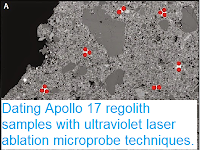At 11.24 am GMT on Monday 14 November the Moon will be at its closest
point to the Earth in 2014, at a distance of 356 511 km. 1 hour and 27 minutes
later at 1.52 pm it will officially be full (completely illuminated when seen from
Earth), which means the two events will be virtually indistinguishable
to human observers, something that has been dubbed the 'Supermoon' by the
popular press. The Moon completes one orbit about the Earth every 27.5
days, and like most orbiting bodies, its orbit is not completely
circular, but slightly elliptical, so that the distance between the two
bodies varies by about 3% over the course of a month. This elliptical
orbit is also not completely regular, it periodically elongates then
returns to normal, making some perigees closer than others. These cycles
mean that the Moon reached its furthest point from the Earth
(apogee) of the year in the same lunar cycle, 406 659 km at 7.30 pm GMT
on Monday 31 October.
Simplified diagram of the Moon's orbit. NASA.
Although this is the closest point to the Earth that the Moon has reached in several decades, it is not exceptional. The Moon reached 356 462 km from the
Earth on 26 January 1948, and will reach 356 477 km from the Earth on 25 November 2034.
See also...







